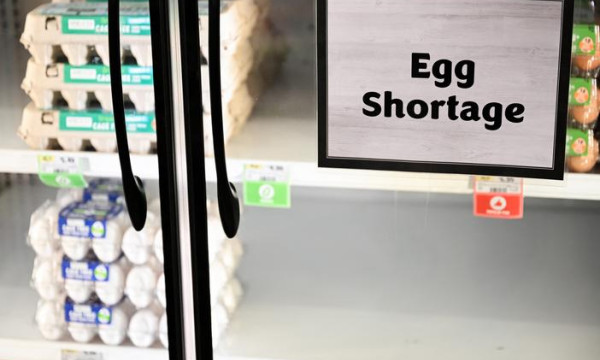Here’s why Canada enjoys an abundance of eggs while the U.S. faces a shortage.

As egg prices have reached an all-time high in the United States, the U.S. Department of Agriculture has started to look to other countries for help with its egg production. The problem may be smaller than they think, however, and could be as simple as turning to their northern neighbor, Canada, where eggs are still readily available and fairly inexpensive.
“We’ve never had any egg shortages here,” says Mike von Massow, an expert in food economics at the University of Guelph in Ontario. “There are 14 types of eggs to choose from for shoppers.” On the other hand, in the United States, the avian flu has killed tens of millions of egg-laying hens, which has led to store buy limits and egg cost surcharges at corporations including Denny’s and Waffle House. Across the border to the north, Canadians have plenty of eggs to go with their bacon without facing a problem.
Von Massow spends a lot of time answering questions from Canadian reporters who are confused about American egg issues. “I say to them, ‘That is an American problem, not ours,’” he says. Canadian chickens are not protected from avian flu, but the effect on supply has been small. Several factors can be attributed to this: The flu is spread by wild birds, which are more common in warmer climates, thus the seals of Canadian barns are tighter; free-range chickens are fewer, which reduces the risk of infection; and, most importantly, the small size of the farms, which does not lead to a catastrophic impact of an outbreak. The average size of Canadian egg farms is 25,000 chickens, while US farms are often over a million, which increases the risk of consequences. “It’s a bigger problem when a single farm provides a significant portion of the production,” von Massow explains.
This wasn’t always the case in the U.S. Jada Thompson, a poultry economist at the University of Arkansas, points out that American egg farms have quadrupled in size since the late 1990s because of the competitive pressure to produce cheap food en masse. “These farms don’t make much profit on each egg, they make profit from selling millions of eggs,” she says. The automation of the processes is more efficient in large flocks, which keeps the costs of U.S. eggs lower than those of Canada – unless there is a problem. “When disease comes, the loss is very high,’ Thompson adds. The USDA reported more than 40 flu outbreaks at commercial egg farms in January and February, killing 28 million hens, 9 percent of the U.S. laying flock, in two months. It can take at least six months to replace them, and the supply is tight as Easter approaches.
This is due to the supply management system in Canada, which ensures that farmers are profitable and do not have to expand endlessly. “I can do very well at this size,” von Massow says of Canadian farmers. “It’s okay, I think, to sacrifice some efficiency for size.” This has also restricted the entry of U.S. eggs, an issue that has become a source of controversy in the two countries’ trade relation. However, with the prices of wholesale eggs in the U.S. falling but the demand likely to rise, importing more Canadian eggs could be a useful solution in the short term if the trade barriers are eased.
The U.S.’s centralized food system has revealed its weaknesses in the past — closed slaughterhouses and one baby formula plant have caused shortages in the last year. For now, it’s just a different picture of Canada’s smaller, more consistent egg farms versus America’s big bet on big farms and a lot of eggs.

Dominic Maley is an American journalist recognized for his sharp and insightful reporting on social and political issues. His work is known for its depth, integrity, and the ability to highlight critical societal concerns.